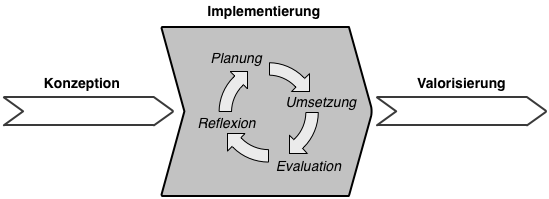
Das Konzept ist in der Regel die Grundlage für den Entscheid für oder gegen die Unterstützung und Durchführung einer Intervention. Darin werden die Ziele der Intervention definiert, Massnahmen aufgelistet sowie Meilensteine gesetzt. Bevor ein Entscheid zugunsten der geplanten Intervention gefällt worden ist, macht es zumindest bei länger dauernden Interventionen noch keinen Sinn, die nachfolgende Phase der Implementierung detailliert zu planen. Detailplanung ist eine Aufgabe der Programm- oder Projektsteuerung in der Phase der Implementierung, unter Berücksichtigung der dynamischen Entwicklungen in den Settings, in denen man intervenieren will. Das zentrale Strukturelement der Steuerung ist eine zeitlich regelmässige Abfolge von Meilensteinen.
Meilensteine sind Haltepunkte in der Implementierungsphase, welche diese in Etappen gliedert und an denen rückblickend der bisherige Verlauf des Projekts überprüft wird und vorausblickend die Feinplanung der folgenden Etappe vorgenommen wird. Es empfiehlt sich daher, die Meilensteine regelmässig auf die Implementierungsphase des Projekts zu verteilen (im Abstand von 3-9 Monaten). Auf diese Weise entstehen in der Implementierungsphase Etappen von gleicher Länge.

Im „klassischen“ Projektmanagement werden Meilensteine als Zeitpunkte definiert, an denen besondere Leistungen erbracht sein müssen, die Voraussetzung sind für nachfolgende Massnahmen. Sie sind primär inhaltlich definiert und können „erreicht“ oder „nicht erreicht“ werden. Bei Interventionen in der Gesundheitsförderung und Prävention ist die wechselseitige Abhängigkeit von Massnahmen auf unterschiedlichen Handlungsebenen in der Regel eher gering und die regelmässige Reflexion aller Aktivitäten auf allen Ebenen steht hier im Vordergrund. Aus diesem Grund sind Meilensteine im Qualitätssystem quint-essenz primär zeitlich definiert. Die Inhalte ergeben sich sekundär durch das Setzen von Zwischenzielen für die verschiedenen Massnahmen, die für den jeweiligen Meilenstein relevant sind.
Die Steuerung von Interventionen in der Gesundheitsförderung und Prävention ist nicht in erster Linie auf das Management von Leistungen der beteiligten Akteure, sondern auf die erzeugten Wirkungen im Zielsystem ausgerichtet.
Regelmässig verteilte Meilensteine mit Zwischenzielen für jede laufende Massnahme dienen retrospektiv der kritischen Reflexion der vorhergehenden Etappe und prospektiv der Detailplanung der nachfolgenden Etappe (vgl. Abb. 1).
Zu Beginn der Implementierungsphase wird die erste Etappe der Durchführung konkretisiert. Für jede Massnahme der ersten Etappe werden, falls dies nicht schon in der Konzeptionsphase geschehen ist, Anfang und Ende, wichtige Termine sowie eine verantwortliche Person festgelegt. Anschliessend wird für jede dieser Massnahmen ein Zwischenziel für den ersten Meilenstein festgelegt.
Zwischenziele definieren die Soll-Werte für den Projektfortschritt. Für die Formulierung von Zwischenzielen gelten die gleichen Kriterien wie für Projektziele - sie sollten überprüfbar und - falls möglich - wirkungsorientiert sein. Wenn das Erreichen eines Zwischenziels nicht unmittelbar erkennbar ist, sind vor dem Ablauf der jeweiligen Etappe evaluative Massnahmen erforderlich.
Die Zwischenziele für die einzelnen Massnahmen bilden nach Ablauf der ersten Etappe, an der ersten Meilensteinsitzung, die Grundlage für eine kritische Reflexion. Welche Zwischenziele konnten erreicht werden? Welche Massnahmen waren erfolgreich, welche nicht? Hat der bisherige Verlauf Konsequenzen für die künftigen Schritte oder müssen Korrekturen vorgenommen werden?
An Meilensteinsitzungen wird das Erreichen der Zwischenziele und die Einhaltung des Budgets überprüft, der Fortschritt des Projekts sowie unvorhergesehene Ereignisse und Entwicklungen reflektiert und Chancen und Risiken und mögliche Konsequenzen für die nachfolgende Etappe diskutiert. Die Sitzungen dienen einerseits der Diskussion fachlicher Fragen, andererseits bieten sie Raum für die Reflexion der Arbeit im Team sowie der Kommunikation innerhalb der Programm- oder Projektorganisation und für die Bearbeitung von Konflikten und anderen persönlichen Themen.
Schliesslich sollten die Leistungen der Akteure gebührend gewürdigt und Erfolge gemeinsam gefeiert werden.
Durch die wiederkehrende Aufgabe der Festlegung von Zwischenzielen für die einzelnen Massnahmen und Überprüfung der Zwischenzielerreichung wird die Steuerung von Interventionen zu einem zyklisch fortschreitenden Prozess, welcher für jede der Etappen vier Aufgaben umfasst:

Die Planung bezieht sich auf die Konkretisierung von Massnahmen und Festlegung von Zwischenzielen. Auf die Umsetzung von Massnahmen folgt deren Evaluation. Zuweilen ist die Zwischenzielerreichung allerdings augenfällig, so dass es keiner besonderen evaluativen Massnahmen bedarf. Die Reflexion in diesem Entwicklungszyklus bezieht sich auf die Effektivität und Effizienz der umgesetzten Massnahmen. Die Ergebnisse werden für die Detailplanung der nächsten Etappe verwendet und somit beginnt ein neuer Zyklus.
Wenn Sie Ihr Programm oder Projekt zeitlich gliedern und Meilensteine als regelmässige Haltepunkte setzen und für die Steuerung nutzen, können Sie auf eine 'veränderte Situation' angemessen reagieren und Fehlentwicklungen rechtzeitig korrigieren. Wenn Sie den Fortschritt des Programms oder Projekts an den Meilensteinsitzungen reklektieren, können Sie in den Zeiträumen zwischen den Meilensteinen konzentriert an der Umsetzung Ihrer Massnahmen arbeiten.
Mit einer sorgfältigen Planung und Umsetzung der ersten Etappe hat Ihre Intervention bessere Chancen auf Erfolg.
Sie können durch Meilensteinsitzungen Ihre Planung flexibel halten und die laufenden Prozesse aktiv und regelmässig steuern. Dadurch werden auch Kreativität und Innovation gefördert. Ein regelmässige Reflexion der Zusammenarbeit kann helfen, Konfliktpotentiale im Team frühzeitig zu erkennen und konstruktive Lösungen zu finden.
Setzen Sie für die Implementierungsphase Meilensteine in regelmässigen Abständen. Formulieren Sie für jeden Meilenstein und jede zu diesem Zeitpunkt relevante Massnahme überprüfbare Zwischenziele.
Berücksichtigen Sie bei Meilensteinsitzungen folgende Aspekte: